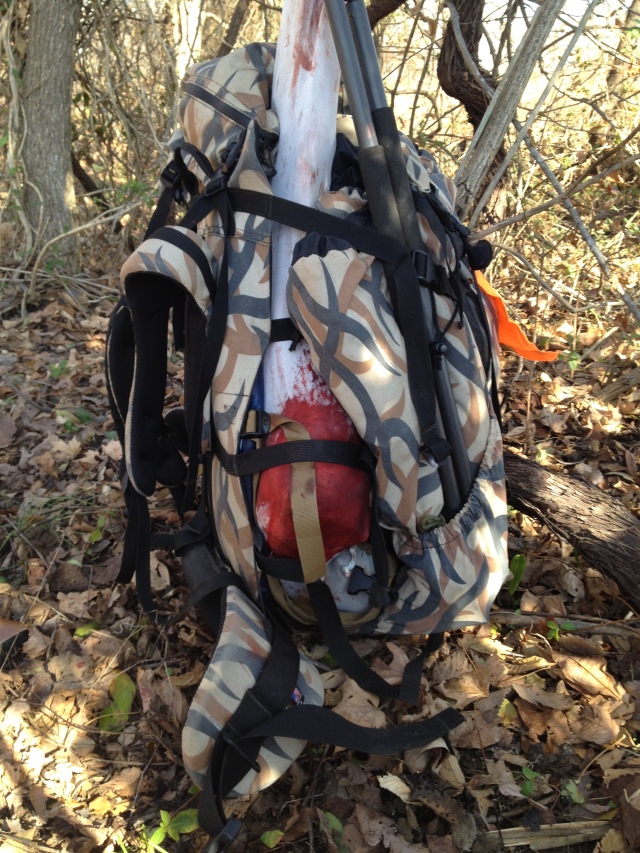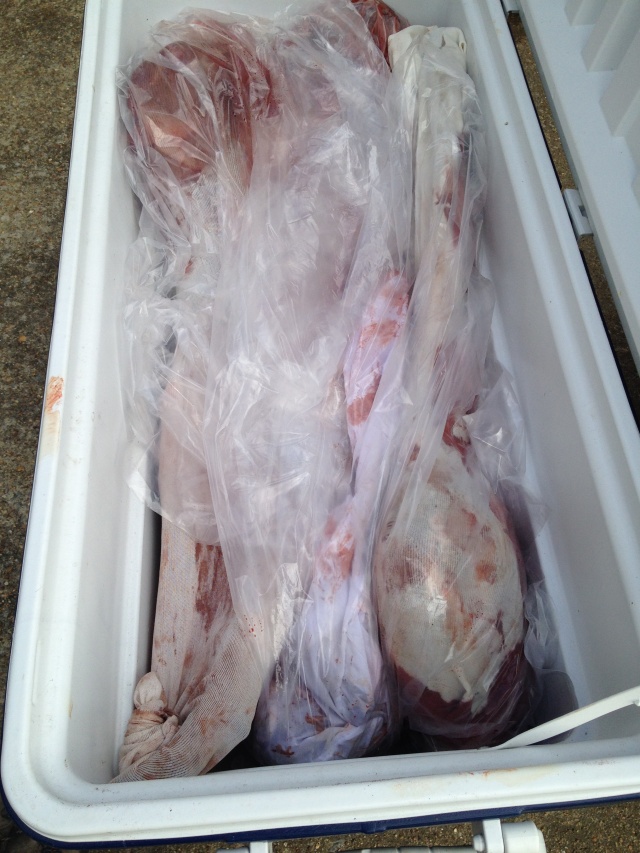I am a big proponent of skinning and butchering game meat as soon as possible. Part of this has to do with the weather this far South in Tennessee where cold fronts usually involve clear, sunny skies, meaning that cold mornings tend to turn into mild days. Animals also tend to be easier to skin while still warm. Additionally, skinning, quartering and even deboning in the field is an important skill for any Eastern hunter who has aspirations to hunt out West. You will get no better primer on learning how to breakdown an Elk, Mule Deer, Black Tail etc in the backcountry than “practicing” on Whitetails, even if you are hunting in an area where field recovery is straightforward. Practically speaking, I look at it like this: I have to skin and quarter a deer anyway, might as well do that in the field. If the weather is cool, I get the work done and keep hunting (Many hunters consider their day afield to be over the second they pull the trigger). Disposal of scraps is immediate and there is no needless deer dragging (I still do not fully understand why dragging deer is consider such a ritual for Eastern hunters -makes no sense).
When I skin and quarter deer in the field, I immediately get all quarters, trimmings, and any offal into game bags. In the past, I have used Alaska Game Bags. These are stretchy, cotton blend bags that do a sufficient job at preventing flies from planting larva on the meat. As I was prepping to go out West, I purchased a set of Tag Bags. These are a tougher, synthetic material that are not as porous as the Alaska bags. Blow flies out West are larger and more aggressive and I wanted to be sure that any potential Elk meat was not tainted with fly larva. The Tag bags do not stretch like the Alaska game bags so there is no fitting anything bigger in the bag than the actual size of the bag. This Fall, I have been using a combination of both brands of bags. I use the stretchy Alaska bags for quarters and the smaller, Tag bags for backstraps, neck meat, flank trimmings and offal.
 Fresh venison packed up in a Exo Mountain Gear pack and ready for the WOD (~80 lbs meat haul for 1+ mile).
Fresh venison packed up in a Exo Mountain Gear pack and ready for the WOD (~80 lbs meat haul for 1+ mile).
Once the meat has cooled, I often place the meat on ice for transportation or, if I am out hunting for a few days, I keep the meat on ice until I get home. Based on observations of other hunters, especially on Instragram these days, I see a lot of critical mistakes. By “critical”, I am not implying that meat is ruined, just that meat is treated less than optimally. Here is the deal: A moist enviroment is a ripe environment for bacteria growth (I took a online meat science class from Univ of Florida this summer and we looked at bacterial growth on meat in relation to moisture quite a bit). Placing your venison directly on ice is not a good idea. (it is better than allowing the meat to spoil, however). Allowing the meat to get submerged in water is even worse. Now, thousands of hunters do both each day and very few, if any of them get sick. That’s fine, but, that doesn’t mean that meat is optimal. Imagine your surprise if you walked into a steak house, ordered the tenderloin and observed the cook pulling a slimey, dripping-wet piece of beef out of ice water. Treat your venison and other game meats like you are going to serve it in a restaurant (i.e. don’t dunk it in water).
So, to avoid exposing the meat to moisture, I simply place the meat in plastic bags while in a cooler. I use the large, leaf bags. Trash bags are fine, but be sure that you do not use scented bags (many trash bags these days are scented) as that will ruin the meat.
 Venison over ice. The plastic bags prevent direct contact with moisture and help to maintain a healthy meat PH balance.
Venison over ice. The plastic bags prevent direct contact with moisture and help to maintain a healthy meat PH balance.
Aging your meat? That process is really not happening to any noticeable extent in ice or on ice in a cooler. You can read more about aging here. In all reality, if you do not have some kind of aging setup, or don’t live in a Northern climate where deer can be hung outside, you are better off processing the meat as soon as possible rather than attempting some kind of aging process in ice. There are too many variables when it comes to meat aging for a simple cooler for of ice to be effective. I realize that this challenges some long held practices with regards to hunting and meat care, but again, consider for a moment how you would react to a steakhouse treating cuts of beef in the same or similar manner to how many hunters treat their venison.
Yeti posted a slick video about properly packing meat into their coolers recently. In order to keep the meat off the melting ice they suggest the top layer of ice be frozen plastic water bottles and then block/cube ice below that.
Regarding not dunking meat in water what method do you recommend in terms of washing hair and organic debris (leaves, sticks, et al) off it once at home? After rinsing my venison in the sink last week it was a bit wet and it sat overnight before I ground it the following day. Apart from drying each piece (maybe that’s what it takes?) is there a different method?
Generally speaking, I see no reason or even advise washing game meat. I realize it is a common practice, but i think that washing the meat creates more problems than it resolves. If you allow the surface of the meat to dry out just a bit, organic debris removes very easily with a cloth or papertowel (even a libt roller!) When the meat is wet, debris sticks to the meat and is difficult to remove.
The main reason i see no need to wash the meat is because water doesnt kill bacteria and any bacteria on the surface of the meat should be killed during the cooking process. excessively dirty meat would be an exception, though.
Thanks for the reply. My purpose was purely to rinse hair, leaf matter, and dirt from the meat. I felt that a quick water rinse was much faster and easier than rubbing and patting each piece with a cloth or paper towel so that was my rationale for opting for it.
Yeah, its fine to do that, but I have found higher quality results (both freezing and consuming ) with Meat that is not wet on the surface. If possible, allow the meat “dry out” after washing.
Better care of keeping the meat clean in the field seems the first step in the process. Then. limiting how wet the meat gets if a rinsing is needed to follow. Thanks for sharing your thoughts.